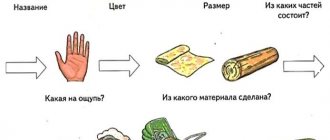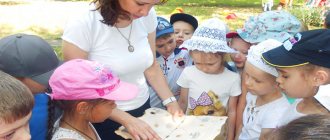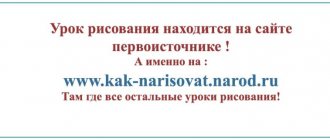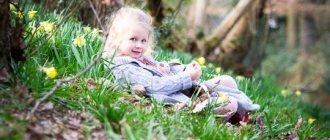Summary of the introductory lesson to the program “In Search of Treasure”; for children 5-6 years old
Zainullina Aigul Borisovna,
additional education teacher
Center for additional education for children "Rainbow",
Langepas town of Khanty - Mansi Autonomous Okrug - Ugra
The topic of the lesson is “In search of treasure”
Introductory lesson for the additional educational program “Developing Together”
Children's age is 5-6 years.
Type of lesson:
game - journey
Time
lesson duration: 25 minutes
Purpose of the lesson:
to awaken in children a cognitive interest in developmental activities, in completing tasks and exercises for the development of the child’s cognitive and intellectual sphere.
Tasks:
Developmental
- Development of attention, observation, memory, imagination.
- Development of fine motor skills of the hands.
- Development of movement coordination.
- Stimulation of speech activity.
Educational
- Creating conditions for children to get to know the teacher.
- Children's ability to work in a team.
Necessary equipment for the lesson:
chest, wood, key, parts from the key, tape recorder, magnetic board, magnets, forms with the labyrinth task, pencils, jump rope, tape, card, letter.
Progress of the lesson.
1. Organizational moment. Welcome speech from the teacher.
The teacher meets the children in the group.
— Hello, my name is Aigul Borisovna! To make it easier for us to communicate, let's stand in a circle (children stand in a circle).
— Tell me, please, what do people do first when they meet? CHILDREN'S RESPONSES.
- That's right, HEALTHY! What does “HEALTH” mean? CHILDREN'S RESPONSES.
Saying hello means wishing you health! Let's wish everyone around the world good health! Repeat after me: (welcome ritual).
- Hello, golden sun! (everyone raises their hands, then lowers them).
- Hello, the sky is blue! (everyone raises their hands, then lowers them).
- Hello, free breeze! (swing their arms).
- Hello, little white snowball! (movement of hands, show snow).
- Hello everyone! (everyone spreads their arms to the sides, then lowers them).
2. Exercise to develop the articulatory apparatus.
- I hope you and I will become friends! Tell me, where does friendship begin? CHILDREN'S RESPONSES.
— Friendship begins with a smile. Let's smile at each other. Well done! And now he’ll repeat after me: I’ll smile at my neighbor! (3-4 times).
And once again give your kindest smile to your neighbors.
3. Announcement of the topic. Explanation of new material.
- Well, we met and became friends. While I was waiting for you, they brought me a letter, it was sent by the Good Witch, and I haven’t had time to read it yet. Let's read it now.
“In the magical forest, the Evil Wizard buried a treasure. Only the most friendly children will be able to find this treasure. When you find a treasure, you will become more attentive, think even better, remember more, you will be able to learn a lot of interesting things... But to find it, you need to pass tests. And to make it easier for you to find the treasure, I’m giving you a map.”
— Do you agree to go on a trip to the Magic Forest? (Children's answers)
3.1. Exercise "Transitions".
Target:
development of attention to each other, group cohesion, coordination of movements.
- Well, let's hit the road. Stand behind each other. With one hand, grab each other's belt, and with the other, hold onto the ribbon. There is no need to separate your hands. We hold on to each other and don’t let go of the ribbon. Ready? (children walk in place, repeating TOP-TOP-TOP - let's go on a hike). Go!
The teacher becomes the first. Light background music is playing. Children walk around the hall and approach the river.
— The first obstacle is “River”, we need to cross it.
3.2. Exercise “River” takes place to cheerful music.
Target:
creating a cheerful mood.
Instructions:
a deep river flows here. We need to cross it and not get our feet wet. Stand one after another, take turns jumping from one bank to the other. Please do not jostle and wait your turn, otherwise you may get your feet wet. Ready?
Time spending
3 min.
“So we crossed the river, none of us got our feet wet.” We have become bolder. But look at the map! There is a high mountain ahead. We need to fly over it.
3.3. Exercise “Who flies?” Target:
development of motor-motor attention.
Instructions:
I will name words that can fly or cannot fly. If you hear a word that can fly, answer: “flies” - and show how it’s done - spread your arms to the sides like wings. If I ask you: “Does the pig fly?”, be silent and do not raise your hands.
List of words: dove, snake, sofa, butterfly, chafer, chair, ram, swallow, plane, tree, seagull, house, sparrow, ant, mosquito, boat, iron, fly, table, dog, carpet, helicopter.
Time spending
4 min.
- Well done, you completed this task, and we flew safely over the mountain and became more attentive. But look at the map - another difficult task lies ahead. The evil wizard tried very hard and confused the tracks so that we could not find the treasure. But you and I are attentive and brave, and we can overcome all difficulties. There's a labyrinth ahead.
To complete this task you need to sit down at your tables.
Do you know WHAT IS A MAZE? (these are many roads mixed up with each other. But there is a path that will lead you out of the maze).
3.4. Exercise "Labyrinth". Target:
development of attention, thinking, hand motor skills.
Instructions:
each of you will receive a piece of paper with a labyrinth. Look how confusing the roads are. You need to find the way to the tree under which the treasure is buried. Go straight along the road, no need to jump over or climb over walls. Draw the road first with your finger, and then, when you find the road, draw it.
Execution time: 1-2 min.
- Great, everyone was able to get out of the maze and find the way to the tree under which the treasure was buried. And here is the chest. But it's closed. And to open it, you need a key. The Evil Wizard did his best here too. He took our key apart. We need to collect it. Each of you takes one piece from the broken key, and put the key together.
3.5.
Exercise “Collect the key.” Goal: development of thinking, attention, group cohesion.
The children are given cut pieces of the key. They need to collect it (collectively, at one of the tables).
Time: 2-3 minutes.
- The key is collected, now we can open the chest.
“But to open the chest, you need to say magic words.” Repeat after me: Key - one, two, three! Unlock the lock for us!
4. Surprise moment.
They open the chest. There are books with tasks for children. Look through the activity book with your children.
- Please tell me why the Good Witch called these books a treasure? CHILDREN'S RESPONSES.
— These books contain the most interesting tasks for you. By completing these tasks, you will be able to become more attentive, learn to think and fantasize even better, and begin to remember better.
- It's time for us to return. I suggest that you do not return along the difficult road, but make a space flight. You will now lie down on the carpet, make yourself comfortable, relax and close your eyes.
5. Relaxation break “Space flight”
(space music plays for 1 minute).
Target:
Relieving tension and excitement in children.
One, two, three, opened their eyes. We looked around. Here we are again in kindergarten.
6. Summing up. Fixing the material.
— Did you like our trip? Why did we go on this journey? What helped us find the treasure? What is this treasure for?
7. Exercise “Sunshine”
(held in the center of the room).
“Now it’s time to say goodbye.” Please go to the center of the hall. Stand in a circle. Stretch your hands forward and join them in the center of the circle. Let's stand quietly and feel like a warm ray of sunshine.
- Thank you very much for the lesson. If you liked our lesson, I’m waiting for you at the Rainbow Center for Continuing Education. Goodbye.
Bibliography:
- Artsishevskaya I.L. Psychologist's work with hyperactive children in kindergarten. – M.: Knigolyub, 2003.
- Notes of integrated classes in the preparatory group of kindergarten. Cognitive development. Speech development. Literacy training: A practical guide for preschool teachers // Auth. Comp. Adzhi A.V. – Voronezh: TC “Teacher”, 2006.
Methods and means of preparing developmental classes
Developmental classes require a careful selection of a combination of methods, that is, a set of ways to implement educational tasks. In this case, the unit of implementation of the method will be a technique - a practical element of work, which, in turn, requires the rational use of means - a set of objects of the subject-development environment and tasks, that is, exercises.
Below is a table where all these concepts are combined into a single system aimed at achieving the objectives of developmental classes.
Table: methods, techniques and exercises for development classes in the preparatory group
| Method | Reception | The essence | Exercises |
| Speech | Questions | In the preparatory group, this technique helps to implement a heuristic approach to acquiring new knowledge: children themselves reach new knowledge. | “Create your own version of a fairy tale” (to develop imagination). The teacher invites the children, based on the answers to the questions, to create their own version of the development of the plot in the fairy tale. Questions for the fairy tale “Turnip”:
|
| Instructions | It is used in developmental classes in physical education, artistic creativity, speech development, physical exercises to guide the progress of children’s work. | At a speech development lesson on the topic “Here the kittens are acrobats,” the teacher invites children to make up sentences with the words: circus, cinema, park: “Look at the cards on the board. Read the words and make up sentences with them.” | |
| Explanation | In parallel with explaining the material through explanation, the teacher develops in children a sense of language and the ability to logically structure monologue and dialogic speech. | At a lesson on speech development on the topic “Polite Words,” the teacher explains to the children the origin of the word “Thank you”: “In ancient times, the word thank you was pronounced as “God bless”: this is how people thanked higher powers for their kind attitude towards them. Over time, the word turned into our usual “thank you,” and the meaning became more material - people express gratitude to each other for various kinds of favors.” | |
| Conversation | The dialogue form of working with children is the most productive, as it gives the children the opportunity to feel like adults, significant, and also, like explanations, helps them learn the rules for constructing logical statements. | In the preparatory group, conversations are conducted of two types: cognitive and ethical. You can see examples of both in the file of conversations for the preparatory group. | |
| Proverbs, sayings, riddles, poems | These techniques are commonly used to motivate children. Rhymes not only attract children's attention, focus them on joint activities, but also develop memory and vocabulary. | To begin considering the topic of music “Motley Pages” related to the study of the seasons, you can begin with a discussion of sayings and proverbs:
The topic of getting to know the outside world “Space” can begin with solving riddles:
Poems can be used not only at the beginning of a lesson, but also at the end, to summarize the study of the material. For example, a FEMP lesson on the topic “Geometric shapes” can be summarized with a rhyme, after listening to which, children name all the mentioned geometric bodies:
| |
| Tongue Twisters | Help kids practice diction. |
| |
| Visual | Images | The visual-figurative type of thinking of children requires rich illustrative material for each topic, which helps to move more easily and quickly to the next stage of perception development - abstract-logical. | |
| Demonstration | The teacher personally shows the entire procedure for performing the exercise. | In classes on the basics of literacy, the teacher shows the elements of writing letters, and on the applique - the order of applying image elements to the substrate. | |
| Show | Presentation of material in the form of videos. Typically used as a basis for conversation. For example, topics for developing ideas about safety in everyday life can be illustrated with a series of cartoons about Arkady Parovozov. Children watch the episode, and then discuss its content and, together with the teacher, formulate rules for safe behavior. | ||
| Observations | A technique that allows you to systematize knowledge about the world around you. | Examples of tasks within the framework of implementing various developmental tasks can be found in the observation file for the preparatory group. | |
| Game | Didactic | Used to familiarize, systematize, and generalize the material. | By clicking on the link, you can familiarize yourself with a card index of didactic games on various topics for children 6–7 years old. |
| Movable | Designed to help children practice basic movements, as well as satisfy the need for physical activity. | The card file of outdoor games in the preparatory group is presented here. | |
| Theatrical | Develops children's creative abilities and reveals their creative potential. | You can see examples of theatrical games here. | |
| Role-playing | They form ideas about patterns of interaction between people in different circumstances (in the hospital, at work, at home). | Examples of tasks can be found in the file of role-playing games for the preparatory group. | |
| Finger | They train fine motor skills, which helps prepare the hand for writing, and this is an important indicator of a child’s readiness for school. | "Cockroaches"
| |
| Practical | Experiments | Children learn to draw conclusions about the phenomena of the surrounding reality through practical interaction with it. | You can view the card index of tasks and the progress of experiments in the preparatory group here. |
| Modeling | Creation of models illustrating connections between elements and properties hidden from direct view. Modeling can be a method of implementing the task of involving parents in educational activities, when children together with adults create models. | Modeling can be made from building material (constructor parts, mosaics), or it can be made from paper. For example, when studying the topic “Modes of Transport,” children make a ship from Lego parts using a design diagram. A version of the project with parents is the “Roadway” layout, with the help of which children can practice traffic rules. | |
| Drawings | A technique that is used not only in classes on artistic and creative development of the corresponding profile, but also as an element of consolidating material in classes in various educational areas. In the preparatory group, children practice previously learned non-traditional drawing techniques (monotype - mirroring traces of paint by applying patterns on one side of a sheet of paper folded in half, drawing with soap bubbles, stamps, etc.). Examples of a card index of drawing themes in non-traditional techniques can be seen in the publication of teacher Pylnova D.K. | ||
| Applications | Like drawings, applications are used in lessons in various areas. For example, to get acquainted with the outside world and consider the signs of different seasons, the applique can be made from pieces of colored paper. | ||
Video: presentation reception - a large collection of tips from Arkady Parovozov
Video: experimenting “Molecules and Bubbles” at a developmental lesson on familiarization with the environment in the preparatory group
Photo gallery: practical techniques in developmental classes
In the process of modeling from building materials, children learn to disassemble assembly diagrams
Imaginative representation of different seasons develops creativity in children
Completing challenging crafts can be a group activity or a project for children and parents
Temporary plan for developmental classes in the preparatory group
A lesson with children 6–7 years old lasts 30 minutes and, as in other age groups, consists of four stages:
- organizational, designed to motivate guys to work (up to 3 minutes);
- the main one, which develops the topic using different methods and techniques, and also includes a physical education pause (up to 12 minutes);
- stages of consolidating the material, that is, practicing new material in tasks of a practical nature (up to 10 minutes);
- the final stage, at which the teacher and children evaluate their activities (up to 5 minutes).
This is interesting. The consolidation stage may not be allocated separately, but fits into the topic development stage.
All stages of topic development must fit into the timing of the lesson in the preparatory group, that is, 30 minutes
Senior group. Senior preschool age. Children 5-6 years old
Summary of an open lesson in the senior group “My native land, which is called Yamal” Program content: To introduce children to the history and traditions of the peoples of the north, to show the peculiarities of culture and life of indigenous peoples, to broaden the horizons of preschoolers. To give an idea of natural resources (oil, gas)
Native land. Develop cognitive interest, speech,...
Summary of an open lesson in mathematics in the senior group “Journey to the Mathematical Kingdom” Summary of an open lesson in mathematics in the senior group “Journey to the Mathematical Kingdom”
I. Program content: Educational tasks: • Practice counting within 10 in forward and reverse order by laying out a number series
(task -1)
• Consolidate knowledge…



